From The CRPG Addict
 |
| The end screen suggests a sequel that probably never came. |
Die Dunkle Dimension
“The Dark Dimension”
Germany
German Design Group (developer and publisher)
Released in 1989 for Commodore 64
Date Started: 29 August 2018
Date Ended: 28 September 2018
Total Hours: 35
Difficulty: Moderate-Hard (3.5/5)
Final Rating: (to come later)
Ranking at time of posting: (to come later)
From one perspective, for the last three days, Die Dunkle Dimension has taken a higher percentage of my waking hours than any other game since I started this blog. I’ve had it running essentially constantly, in a desperate gambit to make this entry my last one. This was important to me because having two long-running games going at the same time feels like a bit of a grind.
From a different perspective, the game occupied so little of my active consciousness that I really only “played” about 2 of the 18 hours I logged since the last entry. The rest of the time, I was mindlessly grinding while watching television, enjoying the fall weather on my deck, and walking on my treadmill. (I’m starting a major exercise effort this week, greatly assisted when I found a way to rig a laptop stand in a way that I can use it while walking.) This is all to say that the game is extremely grindy. Of the 35 hours that it took me to win, easily two-thirds were spent fighting one mindless combat after another, and half the remainder was spent in translation. The actual game content falls reasonably short of 8 hours. But I did enjoy that small portion of time.
 |
| Surrounded by dragons. Once I had the magic armor, even situations like this weren’t really dangerous. |
When I last blogged, I had visited almost all the cities and had found all but one letter of the Evil One’s name. As an anonymous commenter guessed, the full name was TROFNIH, the last letter discovered in the island town of Madraskan. The town also held an armor shop, where after asking me some copy protection questions, the proprietor handed over a suit of magic armor. It was a little overpowered. Once I put it on, hardly any enemy was capable of more than a couple hit points of damage per blow.
After that, I settled in for a period of grinding until I had enough money to purchase the Elvenbow and the location of the Sicaria Draconem sword. Since the max difficulty of enemies scales with the character, I stated to get mummies, dragons, and demons. I bought the Elvenbow first, but I never got much use from it. It’s theoretically quite valuable, as its arrows pass through obstacles and in the right terrain, you can slaughter enemies without even letting them approach you. But since enemies aren’t really dangerous (after you get the armor), once I had the magic sword, it was easier to attack them with the better weapon. Also, the bow requires a “loading” round in between attacks.
 |
| The Elvenbow will still hit that guy. I don’t think the magic bow in Ultima IV does that. |
Mohammed gave me the location of the Sicaria Draconem at the edge of a desert. That left me broke, but then I remembered I hadn’t told the king about the location of Mubrak. When I returned to him and gave him the coordinates, he rewarded me with 2,000 gold.
Now rich yet again, I took the time to train my intelligence up to 15 and then hit both of the Magic Circles, learning spells (for a few hundred gold a pop) from the various wizards, then buying the various reagents necessary to cast those spells. I had to find mandrake in a swamp and buy nightshade (or whatever the game’s equivalent) from a dealer in Mubrak. Herb dealers mostly sold the others.
 |
| Learning a spell. |
For all the difficulty acquiring enough intelligence to cast spells, then the spells themselves, then the reagents, spells really play a minor role in the game. They don’t work for any of the major boss combats. “Cure Poison” is a blessing, and you need magic to cast “Spellbreaker” at some key locations, but that’s really it. The “Magic Bomb” spell–which kills every enemy on the screen–was useful for grinding, but it drains mana fast, so you can’t cast it every combat. Almost every other offensive spell simply saves you a few attack rounds with a regular weapon.
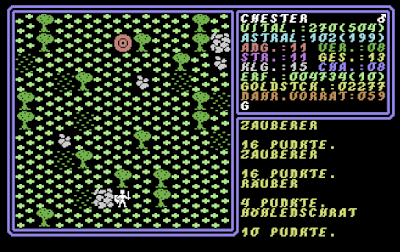 |
| Killing 6 guys at once with “Magic Bomb.” |
After leveling and training some of my stats, my next step was to save the princess from the riesenlindwurm (“giant dragon”), who occupies a cave in the middle of some mountains. To get to him, I first needed to fly, so I went to Gaht and bought a unicorn, and only then realized that I was once again confusing unicorns with pegasuses. The unicorn was unresponsive to my commands to “lüfte!”
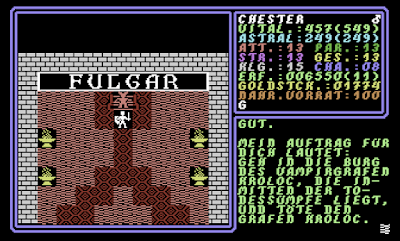 |
| I hope someday I’m powerful enough to build a huge sign that reads “CHESTER” behind my throne. |
I hadn’t previously found the castle, but I soon discovered it amidst the swamps to the south. It was another dungeon, only three stories, and on the top level I killed Kroloc without any trouble.
 |
| Kroloc look remarkably like a balrog. |
Fulgar rewarded me with the Firering, which allows me to walk through lava (“unfortunately, it only protects against lava, not other fire”). The first place to use it was in Fulgar’s castle itself, where a river of lava blocked me from his herd of flying fire lizards. I “boarded” one and had the ultimate transportation.
There’s something awesome about getting the ability to fly over terrain you could previously only explore by land. Enemies couldn’t attack me while I was in flight–they didn’t even spawn. The boat had already given me the ability to fight combats only when I felt like it, and that went doubly so for the fire lizard. Unfortunately, the fire lizard didn’t have any response to the same key that fires cannons on boats. I thought he might breathe fireballs or something.
 |
| Sailing over mountains on my fire lizard. |
The fire lizard, which can only land on squares of grass, got me across the mountains to the lair of the riesenlindwurm, which Google Translate amusingly kept rendering as “giant Indian worm.” His cave is a large one-room affair with the dragon taking up most of it and the princess chained nearby. You have to walk up and defeat each head in turn while all three heads constantly breathe fire at you.
 |
| This trip didn’t work out for me. |
Unfortunately, I was here too soon and was soon crispened. Thus began my second major bout of grinding. It took me over four hours to get from Level 12 to Level 15. I spent most of it outside Mubrak, using “Magic Bomb” whenever I faced a large or difficult group, then frequently darting into town to re-stock on reagents. The most annoying thing about grinding is getting attacked by animal enemies and having to waste time trying to get them to flee, so I generally stood on my boat (which provides the best combat terrain anyway) and used the cannons to blast any horse, cow, or snake that approached. The game’s message seems to be: “It’s bad to kill animals, unless you kill them with cannons.”
At Level 15 (and after training the associated attribute upgrades), I returned to the cave and still died, but I came close enough that I was encouraged. Two tries later, I succeeded in killing the dragon and freeing the princess. She in turn thanked me for saving her and told me that the dragon had discovered the splinter of the crystal and had hidden it in his treasure house, in the cave called Höhle, which I had previously discovered and mapped. She said that his treasure room was blocked by a magic door that requires a dragon’s claw to open, and she cut one of the dead lindwurm‘s claws off and handed it to me.
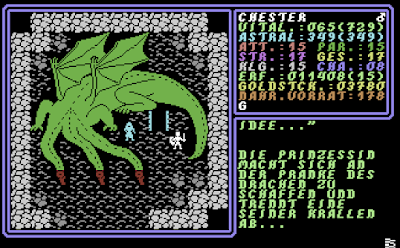 |
| Sheila, demonstrating very little PTSD, considering I left her in the cave with the dragon for months while grinding. |
It was time to explore Höhle again, and that wasn’t so hard. The many combats in the dungeon were more annoyances than actual challenges. I got to the ninth floor, inserted the dragon claw in the doorway, and played my glass flute to attract the splinter.
 |
| There was a little animation of the splinter descending from the ceiling, but I missed it. |
At this point, the game threw me a curve ball by deleting the ladder back to the earlier floors. A brief thread on my last entry confirmed this was a bug in the original, and I downloaded an updated version. I had to reload an earlier save, and do the dungeon again, but I was able to pick up from there.
There was nothing left but the endgame. Unfortunately, I wasn’t ready for it. The Evil One’s lair was on an isle with no grass strip, so I had to purchase another boat and sail to the island. The interior was full of magic barriers that I needed “Spellbreaker” (the only spell that works in the area) to dispel. In between barriers were combats with invisible phantoms and tough golems, and unlike the outdoor combats, there was no way to flee these. It soon became clear I wasn’t strong enough.
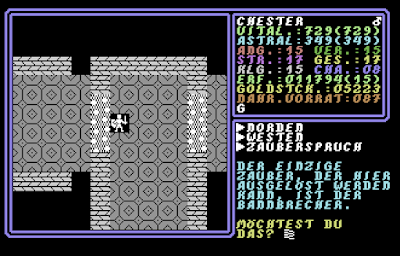 |
| As the game makes clear, “Spellbreaker” is the only spell to work in the final area. “Heal” would have been nice. |
Back for another bout of grinding. After about 3 hours and 2 levels, I tried again and was still defeated. It took me almost another 3 hours to make one more level, and this time I determined to try as many times as necessary until I won. Fortunately, the number of combats you face in the final dungeon is variable, and I got lucky on my third attempt, reaching the endgame with just enough hit points to spare.
 |
| Swarmed by golems in the final area. |
As you enter the final area with the crystal, the Evil One (represented only by a pair of eyes) repeatedly zaps you with magic. But you need only to make it to the square next to the place where the splinter was cut out. You use the splinter and then chant the evil one’s name backwards (HINFORT, which according to commenters means “begone!” in German), and the endgame commences. I don’t think I mentioned that the master of the White Circle walks you through all of this. I visited him a few entries ago, but I see now that I never blogged about it.
 |
| Would “Enogeb” be a good demon name in an English game? |
The endgame text is long:
You lift the splinter high over the scar in the crystal. The splinter blazes up. Your fate will soon be fulfilled. The splinter pulsates warmly in your hand. The crystal begins to vibrate and hum. what do you shout while healing the crystal? (HINFORT). You look at the horrible archdemon firmly in his indescribable eyes and shout “HINFORT!” Then you hurl the splinter down.
Done! The crystal glows and melts with the splinter back to a unity. At the same time, you feel how an unimaginably strong power accumulates in it. The archdemon cries desperately, “NO!” Then the crystal explodes in pure white light.
 |
| Chinese version: “NICHT WOLLEN!” |
The power of the crystal has flung the demon back into the dark abyss of Hell from which it came. Along with the demon vanishes all the evil that bothered the balance of the world. You, too, are caught and thrown up by the force of the crystal. From a great height, you can watch as the damage caused by the demon around the crystal is destroyed. The cloud cover breaks and bright sunlight floods the land. The balance is restored and this dimension is no longer dark.
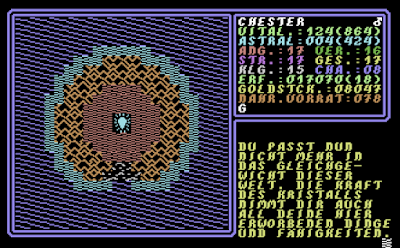 |
| I’m just glad the presence of the sun in our world is not dependent upon a crystal hovering over some lava. |
Your task here is thus fulfilled. You won but what will become of you? You no longer fit into the balance of this world. The power of the crystal also takes away all your items and skills acquired here. You are flung out of the world into the infinite swirling of time and space. Where will you land? Back home? Or perhaps also in the second part: The Black Fortress. Coming soon on this screen.
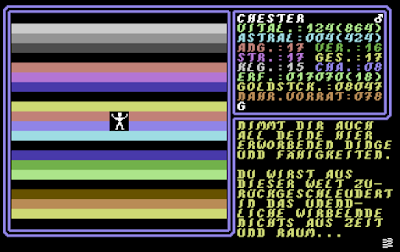 |
| The protagonist hurtles through space and time. |
So once again, in its final moments, Die Dunkle Dimension cribs from Lord British: Immediately upon saving the world, before I can enjoy a proper party or any sort of reward, I’m flung out of it, and I don’t even get to keep the magic items, gold, or skills I acquired. But of course they’ll want me to save the world again in the sequel.
This is a long post already, but I don’t feel like saving the GIMLET for a separate entry, so here we go:
- 5 points for the game world. The manual tells a competent story that is reflected repeatedly in the game.
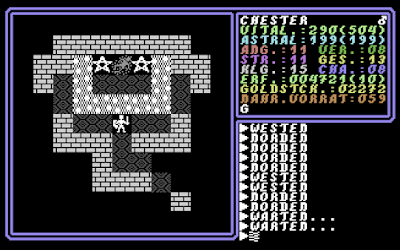 |
| The story says the Black Circle master was burned to a crisp when he summoned the Evil One, and sure enough you can find his body in-game. |
- 3 points for character creation and development. No matter how you start, every character probably gravitates to the same basic mold over the course of the game. Leveling makes you more powerful but doesn’t seem very rewarding at the time, particularly since harder monsters attack you.
- 5 points for NPC interaction. It’s a strong system, drawn from the Ultima series, and I always appreciate keyword-based dialogue. But unlike the Ultima series, we don’t really see any dialog options or role-playing choices inherent in the NPC interaction.
- 3 points for encounters and foes. The monsters are fantasy standard, again many drawn from Ultima IV. They are well-described in the manual, but again in a way that’s mostly plagiarism. There are no serious non-combat encounters.
- 3 points for magic and combat. I like the tactical grid, but there just aren’t many combat options. Magic only works when you don’t really need it. Turning off spells during the game’s hardest encounters was a poor decision.
 |
| Fighting a cyclops in the dungeon. |
- 3 points for equipment. There are a small number of upgrades, and a small number of special items, but it doesn’t play a huge role in the game.
- 4 points for economy. For most of the game, it’s pretty tight, though not complex.
- 3 points for quests. There’s a main quest and at least one side quest, but no role-playing options or alternate endings.
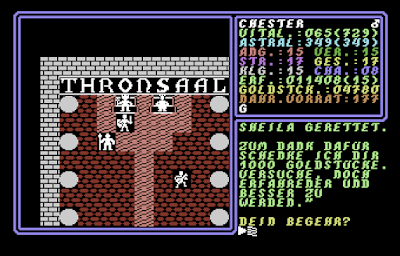 |
| The king is grateful for my rescue of Sheila. |
- 4 points for graphics, sound, and interface. The graphics and sound are serviceable, and the keyboard-based interface is easy to master. I’ll never criticize a game that maps each action to a sensible key.
- 3 points for gameplay. The first half is nonlinear, but the second half isn’t. As such, it really isn’t replayable, and it requires far too much grinding.
That gives us a final score of 36, just above my “recommended” threshold. In a week where I was in a different mood, I’d subtract some extra points for all the grinding that it requires, but for some reason it didn’t bother me this week. Grinding, for all its tedium, requires no ambiguity or complexity, no chance of failure. Sometimes it’s just the thing.
Dunkle isn’t nearly as good as the games it’s based on, but it does retain something of the spirit of those games, and I could see how it would be a good introductory RPG for German players, many of whom have offered fond remembrances in the comments.
The game was originally release on Golden Disk 64 in 1989. Later that year, German Design Group boxed it and offered it to market directly. The primary (perhaps sole) author behind the game is Hendrik Belitz, who would have been in his early 30s when the title was originally released. Belitz ran a web site dedicated to the game from 2001 to 2017, but at some point he lost the domain and it was taken over by junk ads. He seems to have remained active in tabletop RPG gaming, but I can’t find evidence that he’s worked on another CRPG, not even the suggested sequel to Dunkle that would have been called Die Schwarze Festung. I’m glad the game sold so well (I have a note that it sold around 30,000 copies, but I’m not sure where that came from), but it irks me a bit that nowhere in his documentation–not even on his dedicated site years later–does he give any credit to Richard Garriott or Origin Systems for developing the original games from which he copied almost all his mechanics and themes.
 |
| He even stole the gremlin bastard who steals food. |
I’m grateful for any opportunity to get more exposure to German, as I’ve just booked a trip to Munich in early December. It will be my first visit to the country.
“But, Chet!” I hear you saying. “You finished this too quickly! We love your coverage of German Ultima clones! We wish your blog was nothing but that!” Well, I’m happy to please. We turn now to Kayden Garth (1989).
Original URL: http://crpgaddict.blogspot.com/2018/09/die-dunkle-dimension-won-with-summary.html
